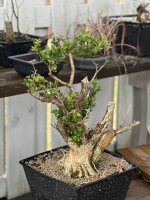Veebs
Yamadori

Hello all, my boxwood is really starting to take off after I worked the roots for the first time this spring. It seems several of the branches didn’t survive the winter though.
I’ve heard boxwoods heal over very slowly, but I’m also mostly only familiar with techniques for juniper deadwood. Should I let the bark fall off and plan to carve some time? Should I try to find the live wood and remove the rest of the bark on my own? Or should I cut back and let the healing begin.
Thanks in advance for any suggestions.
